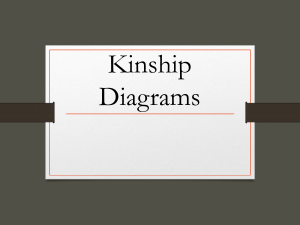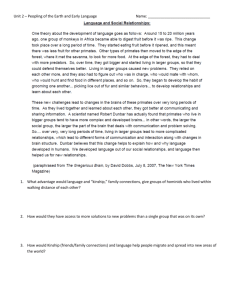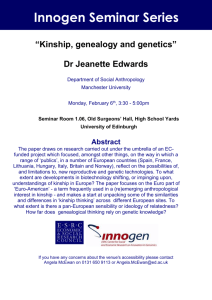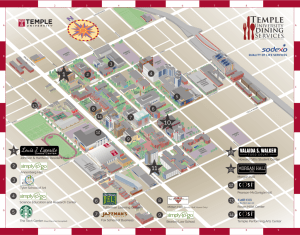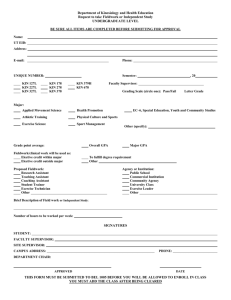kin term map - Eclectic Anthropology Server
advertisement
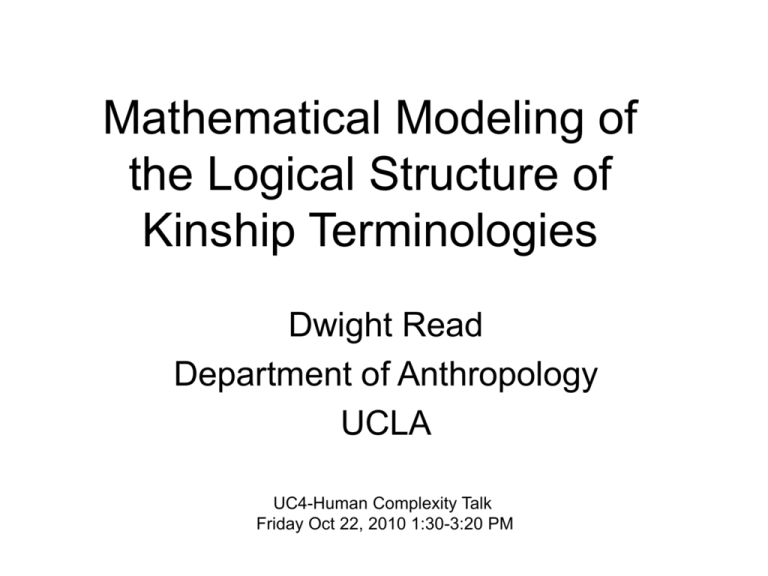
Mathematical Modeling of
the Logical Structure of
Kinship Terminologies
Dwight Read
Department of Anthropology
UCLA
UC4-Human Complexity Talk
Friday Oct 22, 2010 1:30-3:20 PM
What will be shown
• Cultural basis for kinship
– Genealogical Basis (Problems)
– System of symbols (kin terms)
• A kinship terminology is a computational system.
• A kinship terminology has a generative structure.
• Genealogical kin term definitions can be predicted.
• Logical explanation of terminology features.
• Basis for major structural differences between kinship terminologies.
• Kinship space integrates family space, genealogical space and kin
term space
A Cultural Encounter
• Neighbor: “What kind of research do you do?”
• Reply: “I do research on the structure of kinship
terminologies..”
• Neighbor: “What are kinship terminologies?”
• Reply: “These are the words we use to refer to our
relatives -- brother, sister, mother. I’m interested in
explaining why other groups have very different ways
to refer to their relatives”
• Neighbor: “I thought everyone referred to their
relatives the way we do.”
Cultural basis for kinship
Cultural Kinship
Hunter-gatherer
society: !Kung
san
Terminological
Structure
Cultural
kinship Tracing
is not biological kinship:
Genealogical
(Botswana) has around 500 persons
“All
human societies
(genealogy)
basedhave
on: kinship, that is, (kin term map) based on:
they
all impose
some privileged cultural order
Linguistic
symbols
+
Culturally
recognized
Genealogical
tracing:
500
genealogical
over the biological universals of sexual
motherhood and fatherhood paths fromproduct
ego to alloperation
society members
relations and continuous human reproduction
through birth” (Parkin 1997, p. 3, emphasis
!Kung san kinship terminology has 17 kin
added)
genea- geneaterms
Trobriand
logical logical
7 terms used for the nuclear family
mother
father
4 terms for other consanguines
Genetic Tracing
(pedigree) based on:
Genetic reproduction
genetic
father
genetic
mother
abstraction
Tracing preserved,
Structural form
preserved
2 terms for husband/wife
4 terms for other affines
abstraction
Terminology simplifies from 500
genealogical paths to 17 kin American
terms
Products preserved,
Structural form not
preserved
biological
kinship
Kin selection, inclusive fitness
genealogical
kinship
Type of relative
cultural
kinship
Social
identity
Roles
Social Behavior
(multiple structures)
Genealogical Basis
(Problems)
Definition of Kinship
“I define kinship, therefore, [as] a relationship which is
determined, and can be described, by means of
genealogies” (W. H. R. Rivers 1924: 53).
“Kinship is conventionally defined as relationships between
persons based on descent [parent-child links] or
marriage” (Linda Stone 2000: 5)
Family Tree (Genealogy)
mother
father
ego
aunt
uncle
Genealogical Perspective
Genealogical Grid (partial)
Terminology (AKT)
Father, Mother, Uncle,
Aunt, Son, Daughter, Cousin, etc.
=
=
=
ego
=
Aunt
Underlying logic
1. fs = ms = b, fd = md = z
2. sf = df,
sm = dm
3. bz = z,
zb = b
4. sb = s = db, bf = f = zf
5. sz = d = dz, bm = m = zm
Uncle
=
Mother
Father
Uncle Aunt Uncle
ego
Sister
Daughter
Brother
Son
Analytic Methods:
Componential Analysis
Rewrite Rules
American Kin Terms and Genealogy
!Kung San of the Kalahari Desert
!Kung san Camp
!Kung san Terms and Genealogy
Implied definition: !un!a’a = {ff, mf}
txuma = {fm, mm}
Problem: Does not match
usage of kin terms.
“I found that different persons used different
terms in a given [genealogical] relationship …It
was Toma who … told me what he had
assumed everyone knew, that the term ‘followed
the name’” (Lorna Marshall 1976: 202)
!Kung san Terminology
American/English Kin Terms
!Kung San Kin Terms
(approximate)
Grandfather, Great uncle
Grandson, Great nephew
Male cousin (1st, 2nd, 3rd, etc)
Male __cousin twice removed, etc
!gun!a
Grandmother, Great aunt
Granddaughter, Great niece
Female cousin (1st, 2nd, 3rd, etc)
Female __cousin twice removed, etc
//ga
Uncle, nephew,
Male __cousin once removed
Male __cousin 3 times removed, etc
tsu
Aunt, niece
Female __cousin once removed
Female __cousin 3 times removed, etc
tun
Mother
Father
Brother (older)
Sister (older)
Brother (younger), Sister (younger)
Son
Daughter
tai
ba
!go
!kwi
tsi
!ha
≠khai
!, //, ≠ -- click sounds
These four !Kung san terms
are not based on the
genealogical relationship of
the relative to ego, but on
the generational relationship
of the relative to ego’s name
giver.
Who is the Father?
“[their]indigenous theories of procreation have no place
for [the genitor or genetic father], and attribute the
onset of gestation to action by a spirit. One group,
the Murinbata, recognize another social role, the
‘firestick father,’ the individual who, they believe,
directs the spirit to the mother. But the ‘firestick
father’ is neither believed to be a genitor, nor is
necessarily identical with the genetic father. The
distinction between the genetic father and the
‘firestick father’ is shown by the fact that the ‘firestick
father’ is sometimes a woman” (J. A. Barnes
1964:296, from Bronislaw Malinowski 1913).
Procreation ≠ Kinship
“In parts of Melanesia … the family to which a child belongs is not
determined by the physiological act of birth, but depends on the
performance of some social act; in one island the man who pays
the midwife becomes the father of the child and his wife
becomes the mother; in another the father is the man who plants
a leaf of the cycas-tree before the door of the house. These are
only dramatic examples of a widespread practice whereby
fatherhood and motherhood depend, not on procreation and
parturition, but on social convention, and it is evident that bloodrelationship is quite inadequate as a means of defining kinship.”
(W. H. R. Rivers 1924: 53-54)
System of symbols (kin terms)
Kinship Identification and
Calculation
Gao [a Nyae Nyae !Kung] had never been to Khadum [to the north of
the Nyae Nyae region] before. The !Kung who lived there at once
called him ju dole [dole: ‘bad’, ‘worthless’, ‘potentially harmful’]. He
was in haste to say that he had heard that the father of one of the
people at Khadum had the same name as his father and that another
had a brother named Gao. `Oh,’ said the Khadum people in effect, `so
you are Gao’s !gun!a . . .. (Lorna Marshall 1976:242)
[!gun!a -- kin term for persons in a name giver-name receiver relationship]
Gao’s Calculation
(same name)
Gao’s father
B’s brother’s
name is Gao
Unidentified
person B
Gao
A’s father
Unidentified
person A
!gun!a
kin relationship
Gao
!gun!a
Gao
(ego)
tsi (“brother”)
B
?? = tun
Gao … was in haste to say that he had heard that
the father of one of the people at Khadum had the
same name as his father and that another had a
brother named Gao. `Oh,’ said the Khadum people
in effect, `so you are Gao’s !gun!a . . .”
A kinship terminology is a
computational system.
Kin Term Reckoning
Relationship
between concepts:
Relationship between concepts:
“Kinship reckoning on Rossel [New Guinea] does not rely on knowledge of kin-type strings
tp:ee
of tîdê is chênê
daughter of aunt is cousin
[genealogical pathways]. . . . What is essential in order to apply a kin term to an individual
X, is to
know
how term
someone
else, of aofdeterminate kinship
type to
oneself,
refers
to X. of
Call
this
a kin
product
Call this
a kin
term
product
Fromterms
that knowledge
alone,
a correct appellation canthe
be deduced.
For example,
suppose
the
tp:ee and
tîdê
terms daughter
and
aunt
someone I call a tîdê ‘sister’ calls X a tp:ee ‘my child,’ then I can call X a chênê ‘my
nephew,’ without having the faintest idea of my genealogical connection to X.” (Levinson
2002:18, emphasis added)
someone
someone
tîdê
Ego
tp:ee
chênê Person X
aunt
Ego
???
cousin
daughter
Person X
Kin Term Product (example)
Person X
aunt
Ego
son
???
Person Y
cousin
Product of kin terms: Son of Aunt = Cousin
Kin Term Product: Formal Definition
Let K and L be kin terms in a given kinship terminology, T. Let
ego, alter1 and alter2 be three persons each of whose cultural
repertoire includes the kinship terminology, T. The kin term
product of K and L, denoted K o L, is a kin term, M, if any, that
ego may (properly) use to refer to alter2 when ego (properly) uses
the kin term L to refer to alter1 and alter1 (properly) uses the kin
term K to refer to alter2.
alter1
L
ego
K
M
alter2
Construction of a Kin Term Map:
American Kinship Terminology
Grandfather
Father
And so on…..
Mother
Self
Son
Grandmother
Brother
product with father term
product with mother term
product with son term
Kin Term Map: American Kinship Terminology
Nephew of
Grandmother = ?
Shipibo (Horticulturalists)
Kin Term Map: Shipibo Terminology
Shipibo: Horticultural group in Peru
Comparison: AKT and Shipibo
American Kinship Terminology
Shipibo Kinship Terminology
A kinship terminology
has a generative
structure (cultural
theory)
Inductively Derive Cultural Theory
Expressed in the Kin Term Map
Simplify the structure by removing one
structural layer at a time
• Affinal layer
• Sex marking layer
• Descendant and reciprocal term layer
• Core ascendant structure
Remove Affinal Terms, Sex Marking of Terms
Remove affinal
terms (=)
Combine terms in structurally
equivalent positions
Remove Descending Structure, Identify
Core Concepts
X
X
X
[Father, Mother]
X
Self
Remove [son daughter]= child and kin term products of form child of ______ .
Reduce ascending structure to core concepts.
Generate New Kin Term Concepts From
the Core Concepts
We have constructed the primary
meaning of grandparent. Grandparent
is the kin term ego uses for alter2 when
ego refers to alter1 as parent and alter1
refers to alter2 as parent.
Use
We have
the kin
also
term
generated
product to
thegenerate a
new
genealogical
concept: definition
parent ofof
parent
grandparent.
Parent of Parent
Kin Term Product: parent of parent
alter1
[Father, Mother]
parent
m,
Parent
parent
m, f
f
ego
mm, mf, fm, ff
Self
parent of parent
= grandparent
Simplified
kin
genealogical
term maprelation
alter2
m -- mother f -- father
Grandparent
= mother’s
mother’s
father,
Give the new
conceptmother,
a name:
grandparent
father’s mother, or father’s father
Self
Generated
Structure
Continue Forming New Kin Term Concepts
Next we construct parent of
grandparent = parent of parent of
parent in the same manner, and so on.
Parent of Parent
[Father, Mother]
Parent
Self
Self
Simplified kin
term map
Generated
Structure
Generate Core Ascending
Structure
Set of Symbols S = {Self, Parent}. Form all possible
products with Parent: Parent, Parent of Parent =
Parent2, Parent of Parent2 = Parent3, and so on
Etc
Parent2
Parent
Self
Grandparent
Isomorphic
structures
Parent
Self
(ascending structure)
Generate Descending Structure
Descending set of symbols S* = {Self, Child}. Form
all possible products with Child: Child, Child of Child
= Child2, Child of Child2 = Child3, and so on
Parent2
Parent
Self
Child Child2
Reciprocity of Terms
My child
My parent
Parent and child are
reciprocal kin terms
ego, alter1, alter2 blood related
alter1
Generating set {Self, Parent, Child}
Child
Parent
Reciprocal Equation
Parent of Child = Self
ego ?? = Self alter2
ego must be alter2, so ego refers to alter2 as self and Parent of Child = Self
Generate Ascending and Descending
Structure
someone
child
parent
Ego = Person X
grandparent
parent
of parent
parent
self
[uncle,
aunt]of parent
child
of parent
child ofcousin
child of parent of parent
child of parent
[brother,
sister]
[nephew,
child
of child niece]
of parent
child
Descending generating term = child
grandchild
child
of child
Reciprocal terms: parent of child = self
Structure is Isomorphic to Reduced Kin Term Map
I Self
P [Father, Mother] = Parent
C [Son, Daughter] = Child
P2
CP2
C2P2
Isomorphic
P
I
CP
C 2P
C
C2
Sex Marking, Spouse Element
Sex Marking: Add sex markers, M and F, to algebra.
Affinal Terms: Add spouse generating element, S, to
algebra, along with spouse structural equations:
SS = I (Spouse of Spouse = Self)
SP = P (Spouse of Parent = Parent)
Reciprocal equation: CS = C (Child of Spouse = Spouse)
P2S = 0 (Parent of Parent of Spouse is not a kin term)
Reciprocal equation: SC2 = 0 (Spouse of Grandchild is not a kin term)
PSC = 0 (Parent of Spouse of Child is not a kin term)
SCP = CPS (Spouse of Sibling = Sibling of Spouse = Sibling-in-law)
Structural Rules
Sex Marking of kin terms
Cousin nomenclature
Construction Steps
Etc
Etc
(1) Self, Parent:
ascending terms
(2) Self , Child: Grandparent
descending terms Parent
Grandparent
Parent
Self
Self
Etc
(3) Reciprocal Terms:
Parent of Child is Self
Grandparent
Parent
Self
Etc
(4) Sex Marking
GFather,GMother
Father,Mother
Self
Child
Etc
[Uncle, Aunt]
[Brother,Sister]
Cousin
[Nephew, Niece]
Etc
Etc
Grandchild
Etc
Uncle,Aunt
Cousin,Cousin
Etc
Brother,Sister
Nephew, Niece
Etc
Gson,GDaughter
Etc
Child
Etc
Son,Daughter
Grandchild
Etc
Construction Steps (cont’d)
(5) Spouse Term
Spouse of Spouse = Self
Spouse of Parent = Parent
Spouse of Sibling = Sibling of Spouse = Sibling-in-law
Parent of Parent of Spouse is not a kin term
Parent of Spouse of Child is not a kin term
(6) Sex Marking Rule: If spouse of a kin term is a kin term then that kin term and
its reciprocal kin term stay sex marked. Otherwise, sex marking is removed.
Isomorphism Between AKT
and Generated Structure
Algebraic Structure
Kin Term Map
Isomorphism
Kin term genealogical
definitions can be
predicted.
Predicted Kin Term Definitions
STEP 1: Instantiation:
I {ego}
P {f, m}
C {s, d}
S {h, w}
Where:
f = genealogical father
m = genealogical mother
s = genealogical son
d = genealogical daughter
h = husband
w = wife
STEP 2: Construct set products corresponding to
symbol products:
e.g. CP = {s,d} {f, m} = {fs, fd, ms, md} = {b, z}
RESULT: Predicted genealogical diagram
Logical explanation of
terminology features.
An Oddity in Our Terminology
• Kinship terminologies change through time:
cousin became “ith cousin j-times removed”
• “in-law” appears to be the way we mark a
relation by marriage
• There is nothing strange about the words
“aunt-in-law” or “uncle-in -law”
• But husband of aunt is not uncle-in-law and
wife of uncle is not aunt-in-law.
• Why not?
Husband of Aunt = Uncle?
Wife of Uncle = Aunt?
Spouse of Spouse = Self
Spouse of Parent = Parent
Spouse of Sibling = Sibling of Spouse = Sibling-in-law
Parent of Parent of Spouse is not a kin term
Parent of Spouse of Child is not a kin term
Algebraic Structure
Kin Term Map
Isomorphism
An Oddity in Our Terminology
• Kinship terminologies change through time: cousin
became “ith cousin j-times removed”
• “in-law” appears to be the way we mark a relation by
marriage
• There is nothing strange about the words “aunt-inlaw” or “uncle-in -law”
• But husband of aunt is not uncle-in-law and wife of
uncle is not aunt-in-law.
• Why not?
• Answer: The logic of the terminology implies husband
of aunt = uncle and wife of uncle = aunt
Basis for major structural
differences between kinship
terminologies.
Kin Term Map: Kariera Terminology
Kariera (hunter-gatherer group)
Simplify: Remove Affinal Relations
“older brother”
“younger brother”
Remove terms connected by “=“
Simplify: Male Terms
“father”
“older brother”
“younger brother”
“younger brother”
“older brother”
“son”
Restrict to male marked terms.
Include “male self” term
Remove Descending
Structure
“father”
“father”
X
“older brother”
“younger brother”
X
“older brother”
“son”
X
X
X
Remove descending terms
Ascending structure
Remove Ascending Products
“father”
“father”
“older brother”
“older brother”
“son”
Remove product Maeli = Mama of Mama
“son”
Core Structure
“father”
“older brother”
“son”
Generating Terms: Mama, Kaja
Comparison of Core
Structures
“father”
[Father, Mother]
[Brother, Sister]
Self
“older brother”
“son”
[Son, Daughter]
Parent
Kariera Core Structure
Child
American Core Structure With
Brother = Son of Father product
Comparison of Sibling Concepts
Sibling as a derived concept
father
brother
mother
self
son
English:
brother = son of father, mother
sister = daughter of father, mother
sister
Descriptive Terminologies
daughter
Sibling as a primary concept
Mama
(‘father’)
Kaja
(‘o brother’)
Margara
(‘y brother’)
[self, self]
Manga
(‘son’)
Nganga
(‘mother’)
Turdu
(‘o sister’)
Mari
(‘y sister’)
Kundal
(‘daughter’)
“Among the Tangu (New Guinea), “a
person’s
Kariera:descent is of small significance
to‘older
him but
that relationships
with sibling
brother’/’younger
brother’
are
of vital
importance. sister’
Briefly, that
‘older
sister’/’younger
siblingship
is the
determinant that descent
Are primary
concepts
might have been expected to be”
(Burridge 1959: 128).
Classificatory Terminologies
Structure with Sibling
Generator
Ascending generating terms:
{male self, father, Brother}
Ascending Structural Equations:
(1) father of male self = father
(2) Brother of Brother = Brother
(3) father of Brother = father
Descending generating terms:
{male self, son, brother}
Descending Structural Equations
(1*) son of male self = son
(2*) brother of brother = brother
Reciprocal equation:
(3*) son of brother = son
Brother of father = father
Reciprocal Structural Equations
(4) Father of son = male self
(5) Son of father = male self
(6) Brother of brother = male self = brother of Brother
Older, Younger Sibling:
Brother (ascending), brother (descending)
Kinship space integrates
family space, genealogical
space and kin term space
Kinship Space
Family Space
(A) Family space based on filiation and marriage
(B) Family space based on filiation, siblingship and marriage
Genealogical Space
Genealogical Grid (partial)
Terminology (AKT)
Father, Mother, Uncle,
Aunt, Son, Daughter, Cousin, etc.
=
=
=
ego
=
Aunt
Underlying logic
1. fs = ms = b, fd = md = z
2. sf = df,
sm = dm
3. bz = z,
zb = b
4. sb = s = db, bf = f = zf
5. sz = d = dz, bm = m = zm
Uncle
=
Mother
Father
Uncle Aunt Uncle
ego
Sister
Daughter
Brother
Son
Analytic Methods:
Componential Analysis
Rewrite Rules
Kin Term Space
Kinship Space
Summary
Q uickTim e™ and a
decom pr essor
ar e needed t o see t his pict ur e.
Q uickTim e™ and a
decom pr essor
ar e needed t o see t his pict ur e.
Q uickTim e™ and a
decom pr essor
ar e needed t o see t his pict ur e.
Q uickTim e™ and a
decom pr essor
ar e needed t o see t his pict ur e.
• A kinship terminology is a
computational system.
• The generative structure
of a terminology
• Prediction of term
definitions.
Nephew of
Grandmother = ?
Q uickTim e™ and a
decom pr essor
ar e needed t o see t his pict ur e.
Q uickTim e™ and a
decom pr essor
ar e needed t o see t his pict ur e.
Q uickTim e™ and a
decom pr essor
ar e needed t o see t his pict ur e.
Summary (cont’d)
• Basis for differences in
kinship terminologies
• Explanation of
terminology features.
• Account for differences
among terminologies
Conclusion
• We have shown that while reproduction underlies kinship, the
relation between biological fact and cultural construct is wellexpressed by Robert Parkin’s comment:
“All human societies have kinship, that is, they all impose some
privileged cultural order over the biological universals of sexual
relations and continuous human reproduction through birth”
• Kinship terminologies have structure based on a set of symbols
(the kin terms), a binary product defined over those symbols (the
kin term product) and structural equations that give a
terminology its particular structure; that is, terminologies have
the form of algebraic structures and can be mathematically
analyzed using algebraic concepts.
• Mathematical analysis of terminologies leads to new
ethnographic insights into the broad issue of what we mean by
kinship and how kinship is lived in the societies we study as
anthropologists.
• Questions?
Shipibo Terminology
Construction Steps (cont’d)
Spouse of Spouse = Self
Spouse of Parent = Parent
Parent of Parent of Spouse is not a kin term
Spouse of Sibling = Sibling of Spouse = Sibling-in-law
(5) Spouse Term
(6) Sex Marking Rule: If spouse of a kin term is a kin term then
that kin term and its reciprocal kin term stay sex marked.
Otherwise, sex marking is removed.
Etc
Etc
Gfather = GMother
Uncle = Aunt
Cousin
Etc
Father = Mother
Brother,Sister
Nephew, Niece
Etc
Gson,GDaughter
Etc
B-in-law ,Z-in-law
F-in-law ,M-in-law
Self
=
Spouse
=
Son,Daughter
S-in-law ,D-in-law
=
Tiwi Mother
“… when my informant said, ‘My mother fed me when I was small
until my brother was born, but often my mother beat me so hard I
ran away. But Polly, that’s my mother, would come after me and
bring me back,’ I found it unwise and invalid to assume that my
informant was referring to any specific number of ‘mothers’…. Even
in cases where my informant knew that I knew the exact
genealogical relationship between her and her real mother and her
mothers ‘one-granny’ sisters [other women that the informant would
call ‘mother’], she rarely made discrimination unless I demanded it.
In the specific instance quoted above, I found that she was
referring to three ‘mothers,’ only one of whom was named
‘Polly’.”(Jane Goodale 1971:73)
Keesing’s Definition:
Genealogical Network
“’Kinship,’ then, is the network of
relationships created by genealogical
connections, and by social ties (e.g.,
those based on adoption) modeled on
the ‘natural’ relations of genealogical
parenthood” (Keesing, p. 13)
Schneider’s View
“One must take the native’s own categories, the native’s
units, the native’s organization, and articulation of
those categories and follow their definitions, their
symbolic and meaningful divisions wherever they
may lead. When they lead across the lines of
‘kinship’ into politics, economics, education, ritual,
and religion, one must follow them there and include
those areas within the domains which the particular
culture has laid out” (Schneider 1972:51)
Reference versus Address
• Reference: "She's my cousin on my mother's side"
• Address: "Uncle Frank, thanks for the present!”
• Terms of address are more variable: mom, mommy,
mother, mama, mum,…
• Form of address may signal the nature of the
relationship with the kin person: ‘mother’ is more formal
than ‘mom’ when addressing someone
• Terms of reference often have genealogical definitions:
Uncle is father’s brother, mother’s brother, father’s
sister’s husband, mother’s sister husband
• Genealogical definitions may be used to make the kind
of relation more precise: “He’s my uncle -- my mother’s
brother”
Genealogical Grid
Devised as a universal diagram for
expressing genealogical definitions of
kin terms
Problem:
(1) Assumes kin are
first of all
determined from
reproduction
(2) Does not allow for
relative age to be
part of kin terms
Read’s View
• Genealogical tracing is based upon a genealogical father and a
genealogical mother whose definition is culture specific and
used by culture bearers when tracing a linkage between an ego
and an alter. A genealogical parent may, but need not, be
genitor/genetrix; a genealogical parent may, but need not be,
pater/mater.
• Kinship relations are determined via the categorizations that
constitute the kinship terminology and the conceptual linkages
among the categorizations.
• There are two ways in which a link between individuals may be
conceptualized: (1) a link via genealogical tracing and (2) a link
via kin term categorization. Neither can be wholly reduced to
the other.
Predicted Kin Term Definitions
STEP 1: Instantiation:
I --> {ego}
P --> {f, m}
C --> {s, d}
S --> {h, w}
Where:
f = genealogical father
m = genealogical mother
s = genealogical son
d = genealogical daughter
h = husband
w = wife
STEP 2: Construct set products corresponding to
symbol products:
e.g. CP = {f, m}{s,d} = {fs, fd, ms, md} = {b, z]
RESULT: Predicted genealogical diagram
Polysemic Meaning of Mother,
Father (American
Terminology)
John said: “That woman is my mother”
Two meanings, depending on the circumstances:
(1) John is identifying the woman who gave birth to him
(2) John is referring to the woman with whom he has a kin
relationship labeled by the linguistic expression “mother”; for
example, John might be adopted and is referring to the woman
who is his mother by virtue of adoption
Kin term products are based on kin terms used to indicate the
relation linking speaker and referent person
Definition: Kin Term Product
Let K and L be kin terms in a given kinship terminology, T. Let ego,
alter1 and alter2 be three persons each of whose cultural repertoire
includes the kinship terminology, T. The kin term product of K and L,
denoted K o L, is a kin term, M, if any, that ego may (properly) use to
refer to alter2 when ego (properly) uses the kin term L to refer to alter1
and alter1 (properly) uses the kin term K to refer to alter2.
alter1
L
ego
K
M
alter2
